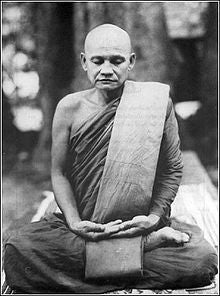
Ajarn Chah
by Jun Wei
·

Ajarn Chah was born on 17th June BE 2461 near Ubon Ratchathani in the Isan region of northeast Thailand. His family were farmers. As part of the culture in Thailand, Ajarn Chah ordained as a novice at the age of 9 whereby he would spend three years learning how to read and write. In the 2017 biography of Ajarn Chah “Tillness Flowing” states that Ajarn Chah took his novice vows in March BE 2474 and that his first teacher was Ajarn Lang. However, Ajarn Chan disrobed as a monk as he went back home to help his family with their farm and was then ordained as a monk on 16th April BE 2482. According to the book “Food for the Heart: The Collected Writings of Ajarn Chah” : he chose to leave the settled monastic life in BE 2488 and became a wandering ascetic after the death of his father. He walked across Thailand, taking teachings at various monasteries. Among his teachers at that time was Ajarn Mun. Ajarn Chah would live in caves and forests while learning from the meditation monks of the Forest Tradition. For the next 7 years, Ajarn Chah practiced in the style of a monk in the Forest Tradition, spending his time in forests, caves and cremation grounds. He wandered through the countryside in search of quiet and secluded places for developing meditation. He would live in tiger and cobra infested jungles, using reflections on death to penetrate to the true meaning of life.
During the early part of the twentieth century, Theravada Buddhism underwent a revival in Thailand under the leadership of outstanding teachers whose intentions were to raise the standards of Buddhist practices throughout the country. One of these teachers was Ajarn Mun Bhuridatta. However please note that Ajarn Chah continued Ajarn Mun's practice when he became a teacher.
The monks of this tradition keep very strictly to the original monastic rule laid down by Buddha known as the vinaya. The early major schisms in the Buddhist sangha were largely due to disagreements over how strictly the training rules should be applied. Some opted for a degree of flexibility (some would argue liberality), whereas others took a conservative view believing that the rules should be kept just as the Buddha had framed them. The Theravada tradition is the heir to the latter view. An example of the strictness of the discipline might be the rule regarding eating: they uphold the rule to only eat between dawn and noon. In the Thai Forest Tradition, monks and nuns go further and observe the 'one eaters practice', whereby they only eat one meal during the morning. This special practice is one of the thirteen dhutanga, optional ascetic practices permitted by the Buddha that are used on an occasional or regular basis to deepen meditation practice and promote contentment with subsistence. Other examples of these practices are sleeping outside under a tree, or dwelling in secluded forests or graveyards.
After years of wandering, Ajarn Chah decided to plant roots in an uninhabited grove near his birthplace. In BE 2497, Wat Nong Pah Pong was established, where Ajarn Chah would teach his simple, practice-based form of meditation. He attracted many disciples which included the first Westerner monk known as Ajarn Sumedho.
In BE 2520, both Ajarn Chah and Ajarn Sumedho were invited to visit the United Kingdom by the English Sangha Trust who wanted to form a residential Sangha.
By the early 1980s, Ajarn Chah's health was in decline due to diabetes. He was taken to Bangkok for surgery to relieve paralysis caused by the diabetes, but it was to little effect. Ajarn Chah used his ill health as a teaching point, emphasizing that it was "a living example of the impermanence of all things...(and) reminded people to endeavor to find a true refuge within themselves, since he would not be able to teach for very much longer". Ajarn Chah would remain bedridden and ultimately unable to speak for ten years until he passed away on 16th January BE 2535 at the age of 73.
However, more than one million people including the Thai royal family attended Ajarn Chah's funeral in January BE 2536 one year after his death due to the "hundreds of thousands of people expected to attend". But things to remember about Ajarn Chah is that he left behind a legacy of Dharma talks, students and temples.